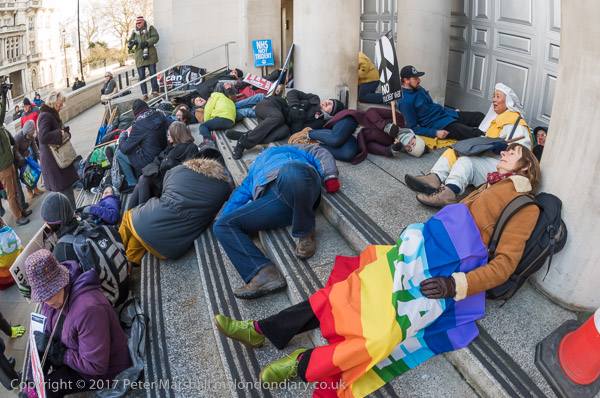
You might think that an organisation which is at least partly British being awarded the Nobel Peace Prize would be news in the UK. If it had been for Chemistry or Medicine or Literature it would certainly have made the headlines on the BBC and at least in the more serious of our newspapers. But I can’t recall hearing anything about the 2017 Nobel Peace Prize. Nor for that matter about the achievement which gained it for ICAN, the United Nations global nuclear ban treaty, already signed by 122 nations.
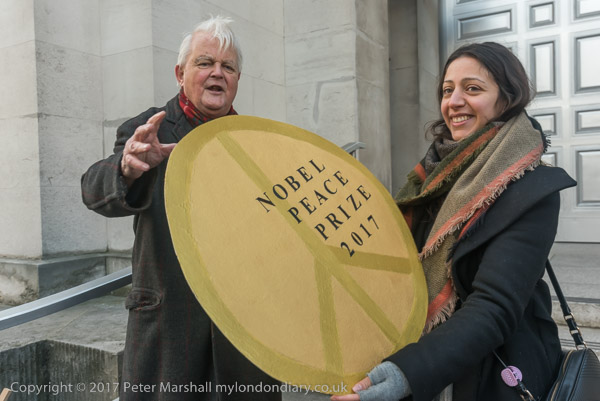
Bruce Kent presents a rather large Nobel Prize to ICAN
ICAN, the International Campaign to Abolish Nuclear Weapons, has been as effectively blanked by UK media as if it was covered by a government ‘D notice’. First introduced in 1912, D-Notices were official requests to news editors not to publish or broadcast items on specified subjects for reasons of national security. They still exist, though in the 1990s they became DA-Notices and are now DSMA-notices (Defence and Security Media Advisory Notices) and come under five headings. It’s just possible that this Nobel Prize might be covered by an advisory note under DSMA-Notice 02: Nuclear and Non-Nuclear Weapon Systems and Equipment but rather more likely that it simply reflects an establishment prejudice against the UK organisations involved. And in any case, D-Notices are only advisory, and when it suits them newspapers and even the BBC have ignored them.
For some of our newspapers and their billionaire owners anyone not entirely gung-ho about nuking Russia even if it might mean the end of the world as we know it is some kind of commie sandal-wearing jesus-loving hippie freak. And probably gay to boot.
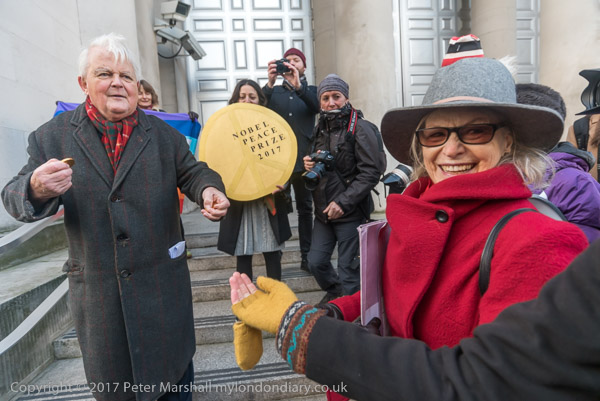
And hands out smaller chocolate ones to the rest of those present
Among those UK organisations which are a part of ICA are CND, which has campaigend since the 1950s for the UK to unilaterally give up its nuclear capability, Medact, a UK charity of health professionals working on issues related to economic justice, ecological health, human rights, and peace, and WILPF, the Women’s International League for Peace and Freedom.
Fifty years ago, when CND was something of a mass movement, the UK government attempted to counter its arguments for unilateral nuclear disarmament by saying that of course they were against nuclear weapons too, but that they wanted not a unilateral disarmament that would leave Britain at the mercy of the remaining nuclear powers, but a multilateral treaty involving the world giving up nuclear weapons. But now the UN has come up with this, our government – and the other nuclear powers – will have nothing to do with it. Not only have the UK refused to sign it, they refused to take any part in the negotiations that led to it.
Given the lack of acclaim for the award in the media, CND and the others decided to hold their own mini-awards ceremony on the steps of the Defence Minsitry, along with a die-in, and called on the UK to abandon Trident and sign the nuclear disarmament treaty.
As the die-in approached, I decided to change from the 28-200mm to the 16mm fisheye so that when people started to get down on the ground I had two wide-angle options, with the 18-35mm on the other camera. I didn’t want to actually get in the area with those taking part, because I find it extremely annoying when other photographers do this, standing up in the middle of everyone who is on the floor and getting in everyone else’s pictures, but decided I could run up the side of the steps at the edge of those in the die-in. Mostly too I would be behind a pillar and largely hidden from those photographers who had stayed at the bottom of the steps.
I was fortunate that one of the protesters there had wrapped herself in a peace flag, as you can see from the picture at the top of this post. Unusually for me this is an uncorrected fisheye image. I think because the steps themselves are not particularly curved the curvature of the elements around the edges of the picture is less disturbing. In any case, when you work with the camera not level, converting to cylindrical perspective gives steeply converging (or diverging) verticals which often is not a good to see. If the effect is only slight then that too can be corrected, but then you start to crop the picture, losing some of its wide impact.
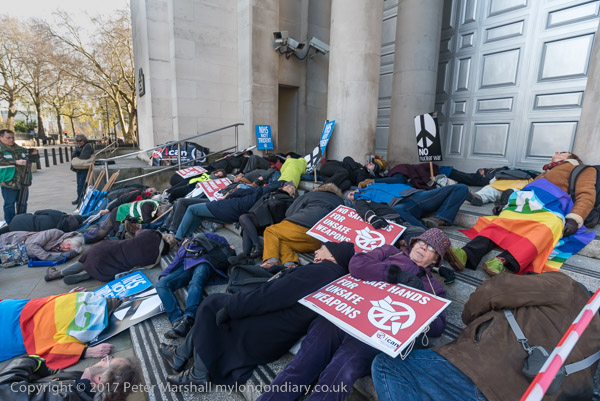
When I’d taken a few pictures there, I came down to get a view across in a diagonal, which helped to give an impression of a fairly large number of people. From the bottom of the steps the numbers looked rather thinner, and I changed back to the longer lens to concentrate on details rather than the whole scene.
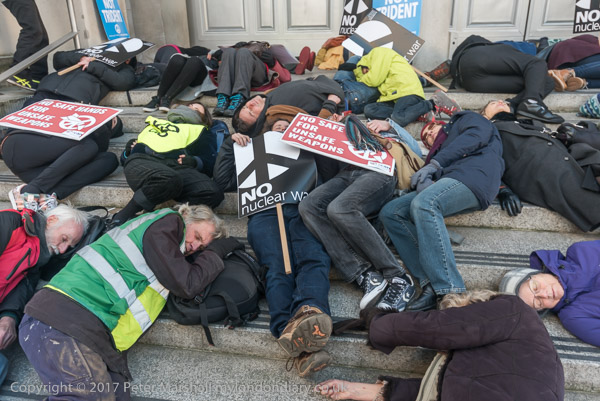
______________________________________________________
There are no adverts on this site and it receives no sponsorship, and I like to keep it that way. But it does take a considerable amount of my time and thought, and if you enjoy reading it, a small donation – perhaps the cost of a beer – would be appreciated.
My London Diary : London Photos : Hull : River Lea/Lee Valley : London’s Industrial Heritage
All photographs on this and my other sites, unless otherwise stated, are taken by and copyright of Peter Marshall, and are available for reproduction or can be bought as prints.
To order prints or reproduce images
________________________________________________________